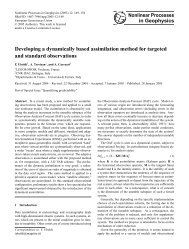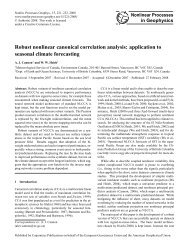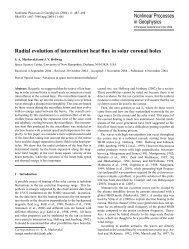Long solitary internal waves in stable stratifications
Long solitary internal waves in stable stratifications
Long solitary internal waves in stable stratifications
You also want an ePaper? Increase the reach of your titles
YUMPU automatically turns print PDFs into web optimized ePapers that Google loves.
W. B. Zimmerman and J. M. Rees: <strong>Long</strong> <strong>solitary</strong> <strong>waves</strong> 167<br />
Fig. 1. Temperature (re-based) and vertical velocity of a <strong>solitary</strong><br />
disturbance observed at Halley Station by the British Antarctic Survey<br />
on 6 June 1986 at a height of 16 m. Measurements were made<br />
us<strong>in</strong>g a sonic anemometer and were recorded at 20 Hz.<br />
Fig. 2. Temperature (re-based) and vertical velocity of a <strong>solitary</strong><br />
disturbance observed at Halley Station by the British Antarctic Survey<br />
on 14 August 1986.<br />
L radiate vertically. From the def<strong>in</strong>ition (4), there are two<br />
dist<strong>in</strong>ct cases: L 2 > 0, where longer <strong>waves</strong> radiate vertically;<br />
L 2 < 0, where all wavenumbers are trapped. In this latter<br />
case, the lack of radiation vertically is consistent with the<br />
boundary conditions of the model adopted by Benney (1966)<br />
and Benjam<strong>in</strong> (1966) lead<strong>in</strong>g to the KdV theory–parallel, impenetrable<br />
stress-free surfaces. Although <strong>in</strong> this paper the<br />
focus is on wave propagation with L 2 > 0, observations of<br />
both cases <strong>in</strong> the STABLE data sets of the British Antarctic<br />
Survey are reported.<br />
When L 2 > 0, from the analysis of Scorer, it is clear that<br />
the k = 0 long wave limit is <strong>in</strong>accessible when shear and<br />
stratification establish a waveguide that is one stratum of the<br />
deeper fluid, s<strong>in</strong>ce all wavenumbers smaller than |L| will radiate<br />
vertically. Thus, long times after the <strong>in</strong>itial disturbance<br />
show depletion <strong>in</strong> the horizontal waveguide of energy <strong>in</strong> the<br />
k ∈ [0, |L|) band. However, for wavenumbers greater than<br />
|L|, the upper and lower surfaces of waveguide do act as material<br />
surfaces, s<strong>in</strong>ce these wavenumbers are trapped. It follows<br />
that the proper nonl<strong>in</strong>earisation of the l<strong>in</strong>ear dispersive<br />
<strong>waves</strong> is bounded below <strong>in</strong> wavenumber space by |L|, and<br />
is, therefore, dist<strong>in</strong>ctly different from the analysis of Benney<br />
(1966) and Benjam<strong>in</strong> (1966), which start from <strong>in</strong>f<strong>in</strong>itely<br />
long <strong>waves</strong> <strong>in</strong> the lead<strong>in</strong>g order separation condition (3). In<br />
the theory that follows, the basic disturbance is taken to be a<br />
harmonic wave with wavenumber k 2 > L 2 , and the first solvability<br />
condition leads to an NEE similar <strong>in</strong> form to the KdV<br />
equation.<br />
The paper is organised as follows: In Sect. 2, two wave<br />
events with L 2 of different signs are reported from the British<br />
Antarctic Survey STABLE data sets (K<strong>in</strong>g and Anderson,<br />
1988). In Sect. 3, a KdV-like theory for arbitrary wavelength<br />
basic disturbances is derived. When L 2 > 0, the theory is<br />
only applicable for nearly monochromatic disturbances. For<br />
L 2 < 0, the trapp<strong>in</strong>g <strong>in</strong> the waveguide is complete and the<br />
theory is generally applicable. Section 4 discusses the re-<br />
sults of the theory, demonstrat<strong>in</strong>g an analytic solution to the<br />
full NEE. Furthermore, the prediction that the halfwidth of<br />
the <strong>solitary</strong> wave by the Scorer parameter, which is demonstrated<br />
<strong>in</strong> Sect. 2 on the STABLE data set, holds theoretically<br />
<strong>in</strong> large Ri waveguides. Section 6 explores numerical simulations<br />
of the NEE, which provide some evidence of solitonic<br />
behaviour for the dynamics of overtak<strong>in</strong>g collisions <strong>in</strong>volv<strong>in</strong>g<br />
<strong>solitary</strong> wave solutions to the NEE. In Sect. 6, conclusions<br />
are drawn.<br />
2 Observations of atmospheric <strong>solitary</strong> disturbances <strong>in</strong><br />
the Antarctic<br />
As a result of strong radiative cool<strong>in</strong>g at the earth’s surface<br />
dur<strong>in</strong>g the Antarctic w<strong>in</strong>ter, a strong, long-last<strong>in</strong>g, stably<br />
stratified atmospheric boundary layer is established at Halley<br />
IV station, Antarctica (75.6 ◦ S, 26.7 ◦ W). Halley IV station<br />
is situated on the Brunt Ice Shelf which provides a uniform<br />
fetch of 10–40 km <strong>in</strong> all directions. Thus the site serves<br />
as an “ideal” natural laboratory for the study of the <strong>stable</strong><br />
atmospheric boundary layer and any wave-like structures it<br />
may support. The British Antarctic Survey have compiled<br />
a database of meteorological measurements from Halley IV<br />
station dur<strong>in</strong>g their STABLE project for the purpose of develop<strong>in</strong>g<br />
a climatology of gravity wave activity <strong>in</strong> the boundary<br />
layer (K<strong>in</strong>g and Anderson, 1988; Rees, 1991; Rees et al.,<br />
2000). The <strong>solitary</strong> large amplitude disturbances reported<br />
here are typical examples of several observations <strong>in</strong> the data<br />
set. The meteorological data recorded <strong>in</strong> the 1986 STABLE<br />
project <strong>in</strong>cluded w<strong>in</strong>d speed, w<strong>in</strong>d direction, and temperature<br />
on a 32 m mast, with measurements at six heights.<br />
Figure 1 shows the temperature fluctuation about an arbitrary<br />
mean and vertical velocity of a wave event recorded<br />
6 June 1986 at a height of 16 m. By eye, it is apparent that the<br />
fundamental assumption of both the KdV theory and BDO






